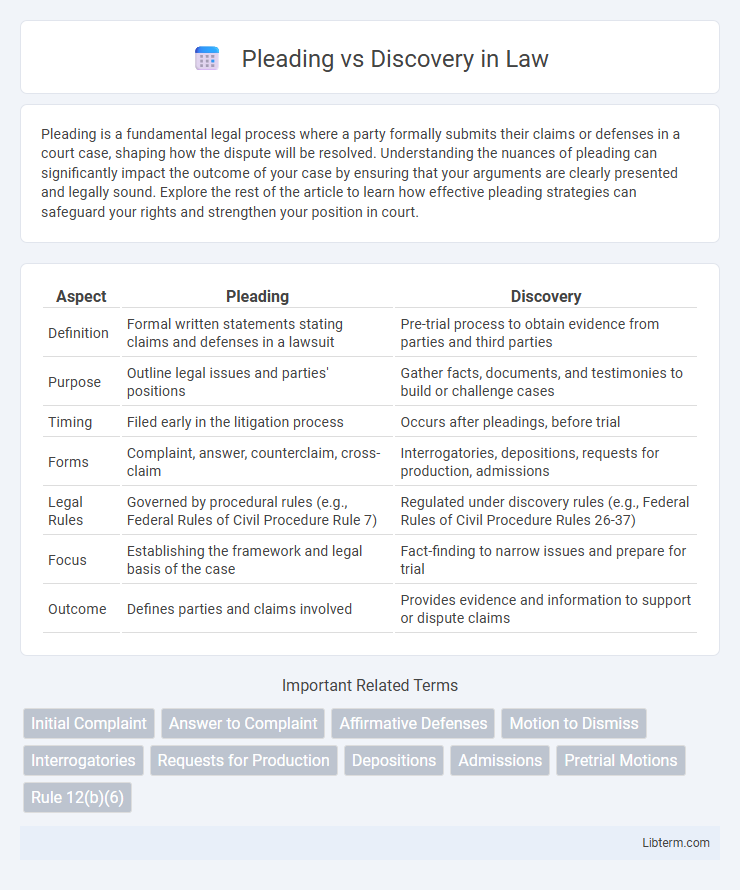Pleading is a fundamental legal process where a party formally submits their claims or defenses in a court case, shaping how the dispute will be resolved. Understanding the nuances of pleading can significantly impact the outcome of your case by ensuring that your arguments are clearly presented and legally sound. Explore the rest of the article to learn how effective pleading strategies can safeguard your rights and strengthen your position in court.
Table of Comparison
| Aspect | Pleading | Discovery |
|---|---|---|
| Definition | Formal written statements stating claims and defenses in a lawsuit | Pre-trial process to obtain evidence from parties and third parties |
| Purpose | Outline legal issues and parties' positions | Gather facts, documents, and testimonies to build or challenge cases |
| Timing | Filed early in the litigation process | Occurs after pleadings, before trial |
| Forms | Complaint, answer, counterclaim, cross-claim | Interrogatories, depositions, requests for production, admissions |
| Legal Rules | Governed by procedural rules (e.g., Federal Rules of Civil Procedure Rule 7) | Regulated under discovery rules (e.g., Federal Rules of Civil Procedure Rules 26-37) |
| Focus | Establishing the framework and legal basis of the case | Fact-finding to narrow issues and prepare for trial |
| Outcome | Defines parties and claims involved | Provides evidence and information to support or dispute claims |
Introduction to Pleading and Discovery
Pleading initiates the legal process by formally presenting claims and defenses through documents such as complaints and answers, establishing the foundation of the case. Discovery follows, allowing parties to gather factual information using tools like interrogatories, depositions, and document requests to build evidence and assess the strengths and weaknesses of the claims. Understanding the distinct roles of pleading and discovery is critical for effective litigation strategy and case management.
Defining Pleading in Legal Context
Pleading in the legal context refers to the formal written statements submitted by parties in a lawsuit, outlining their claims, defenses, and the issues to be adjudicated. These documents, including complaints, answers, and counterclaims, establish the foundation for the court's understanding of the dispute and frame the scope of the litigation. Unlike discovery, which involves gathering evidence and information from the opposing party, pleading serves as the initial step in clarifying legal positions and setting the course for subsequent procedural actions.
What is Discovery in Litigation?
Discovery in litigation is a pre-trial phase where parties exchange relevant information and evidence to build their cases. It includes methods such as depositions, interrogatories, requests for production of documents, and admissions. Effective discovery helps clarify facts, narrow issues, and prevent surprises during trial.
Key Differences Between Pleading and Discovery
Pleading refers to the initial stage of a lawsuit where parties formally submit their claims and defenses through documents like complaints and answers, establishing the issues to be litigated. Discovery involves the pre-trial process of exchanging relevant information and evidence between parties through depositions, interrogatories, and request for production, aimed at building each side's case. The key difference lies in pleading defining legal positions, while discovery focuses on fact-finding to support those positions.
The Role of Pleadings in a Lawsuit
Pleadings establish the foundation of a lawsuit by formally presenting each party's claims, defenses, and legal positions to the court. They define the scope of the dispute, framing the issues for both the court's consideration and subsequent discovery processes. Accurate and detailed pleadings ensure clarity in the case, guiding evidence gathering and legal argumentation throughout litigation.
Importance of Discovery in Case Preparation
Discovery plays a critical role in case preparation by enabling parties to gather essential evidence and clarify facts through methods like depositions, interrogatories, and document requests. Unlike pleading, which outlines initial claims and defenses, discovery uncovers detailed information that shapes legal strategies and supports or refutes arguments. Effective discovery enhances trial readiness, reduces surprises, and promotes fair settlements by revealing the strengths and weaknesses of each side's case.
Pleading Requirements and Procedures
Pleading requirements mandate that a complaint clearly states the facts supporting each claim and the relief sought, ensuring sufficient detail to notify the defendant of the allegations. Procedures require timely filing and service of the pleading on all parties, adhering to specific formatting and jurisdictional rules to maintain court compliance. Meeting these standards is essential to prevent dismissal and to establish a foundation for subsequent discovery phases.
Stages and Methods of Discovery
Pleading marks the initial stage in litigation, where parties formally state their claims and defenses through documents like complaints and answers. Discovery follows, involving methods such as depositions, interrogatories, requests for production, and requests for admission to gather evidence and clarify issues before trial. Effective discovery enables parties to uncover pertinent facts, assess the strength of claims, and facilitate settlements or trial preparation.
Common Challenges in Pleading and Discovery
Common challenges in pleading include ensuring clarity and specificity to meet legal standards, avoiding vague allegations, and properly framing claims to withstand motion to dismiss. In discovery, difficulties often arise from managing voluminous documents, navigating objections to information requests, and maintaining compliance with deadlines while protecting privileged information. Both phases demand meticulous attention to procedural rules and strategic planning to avoid adverse rulings and preserve case integrity.
How Pleading and Discovery Impact Case Outcomes
Pleading sets the foundation of a case by clearly defining the claims and defenses, influencing the scope and direction of the legal dispute. Discovery allows parties to gather crucial evidence, which can validate or undermine the pleadings and significantly affect settlement negotiations or trial strategies. Effective pleadings combined with thorough discovery improve the likelihood of a favorable case outcome by ensuring issues are well-defined and supported by factual evidence.
Pleading Infographic

 libterm.com
libterm.com